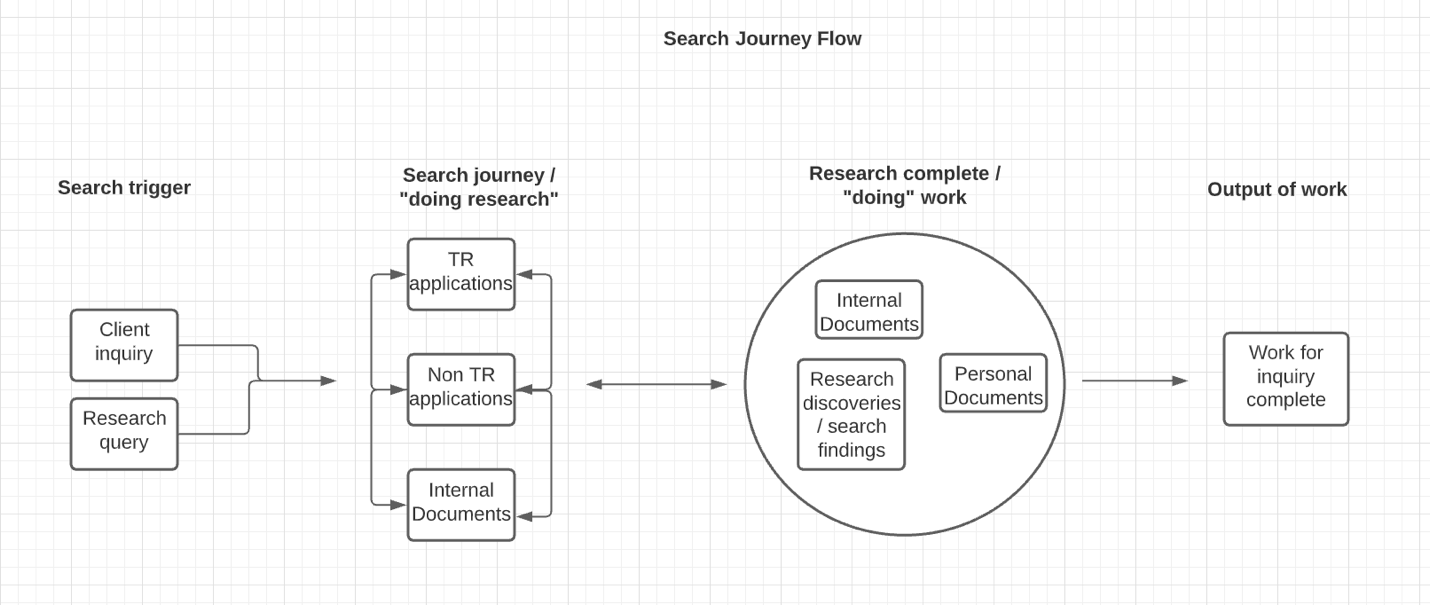PROJECT OVERVIEW
The innovation team was tasked with creating a proof of concept (POC) for a unified search service—a product designed to give customers a seamless way to search across internal and external platforms.
users currently struggle with fragmented, inconsistent search experiencesthat waste time, cause frustration, and erode trust in results. Without a reliable, company-wide search solution, many default to external tools like Google—risking lost insights and lowered productivity.
What’s breaking down in our users’ native search journeys?
Could a unified search service finally solve these pain points and empower customers?
This project supported broader goals of improving search efficiency, reducing friction, and restoring trust in internal tools.
I addressed these challenges through research, resulting in 3 strategic aims:
🎯 Understand User Search Behaviors
Deeply uncover how customers currently search and where they face challenges.
🎯 Validate the Need for Unified Search
Confirm whether a seamless, cross-platform search solves real user problems.
🎯 Shift Focus to User-Centered Design
Move the team’s mindset from competitor benchmarking to solving authentic customer needs.

Budget
$1m

Team
Lead UX Researcher, 1 UX Designer
2 Product Owners, 1 Sr. Business Lead

Timeline
4 weeks
Research Goals & Approach
We used a two-pronged research approach to map customers’ native search journeys, uncover unmet needs, and ensure the product direction was driven by users — not competitors.
RG1: Analyze users’ behaviors, experiences, and patterns during native search across multiple platforms to reveal pain points and unmet needs.
RG2: Evaluate whether a unified search capability across company products addresses real user needs and improves search efficiency.
RG3:Investigate why previous internal search solutions failed, considering reach, placement, and content, to guide future design improvements.
Stakeholder Interviews
Requirements Gathering
Affinity Map
8 1:1 Interviews
Facilitation Guide
Surveys
Thematic Analysis
Process Flow Map
Internal & External Stakeholder Presentations
⚙️Process | 📦 Artifacts ▸
Intent
Align stakeholders and uncover critical gaps and breakdowns in user search journeys to inform a strategic, user-centered discovery framework.
⚙️ Conducted stakeholder interviews to surface critical gaps and conflicting user needs in search journeys.
⚙️ Gathered and analyzed user requirements to identify patterns and clarify search behaviors.
⚙️ Mapped current search workflows to highlight bottlenecks and breakdowns impacting user experience.
📦 Affinity Map v0
⚙️Process | 📦 Artifacts ▸
Intent
Lead collaborative affinity mapping workshops to uncover patterns, gaps, and alignments in user search journeys that drive focused and strategic user research.
⚙️ Facilitated affinity mapping workshops to uncover patterns, gaps, and alignments in current user search journeys.
📦 Affinity Map
⚙️Process | 📦 Artifacts ▸
Intent
Validate insights and uncover search behaviors to inform product direction.
⚙️ Conducted 8 1:1 semi-structured interviews to uncover search behaviors and validate pain points shaping product direction.
⚙️ Synthesized interview and survey data using thematic analysis to identify recurring pain points and unmet needs.
📦 Facilitation Guide, Survey, Thematic Analysis
⚙️Process | 📦 Artifacts ▸
Intent
Translate user insights into prioritized opportunities that inform product strategy and roadmap decisions.
⚙️ Created a process flow map of the unified search journey to expose opportunities and define next steps.
⚙️ Presented insights to internal and external stakeholders to align teams and guide solution design.
📦 Process Flow Map, Presentations
Challenges
Reframed the problem to prioritize real user pain points and validate the need for a unified search solution.
Synthesized diverse insights to reveal patterns, gaps, and high-priority opportunities.
I can’t always tell which results are relevant, so I end up wasting time or just giving up and going to Google when I’m in a rush.
– Candidate 7
Key Discoveries
Search Behaviors & Motivators
Insight 1: Users start searching broadly, fueled by client inquiries. They iteratively narrow searches based on experience and trust. ▸
- Familiarity with the application guides search behavior.
- Trust in results is never absolute; users continuously assess relevance.
Solution 1: Guide users from broad to narrow searches with contextual cues. Build trust and reduce friction. ▸
- Simplify interface to reduce cognitive load.
- Provide contextual cues and trust signals to guide iterative refinement.
Search Refinement & Relevancy
Insight 2: Users struggle to judge relevance mid-search, and may abandon under time pressure. ▸
- Users don’t know immediately which results are relevant.
- Lack of clarity leads to abandonment.
- Time pressure accelerates drop-off.
Solution 2: Surface strong signals and refinement mid-search; prevent abandonment. ▸
- Highlight top results to help users quickly judge relevance.
- Provide rapid refinement paths(filters, smart suggestions).
- Reduce uncertainty with cues that prevent drop-off.
Searching Under Time Pressure
Insight 3: Under time pressure, users skip internal search and rely on Google, risking missed insights. ▸
- Time constraints prevent exploration of alternative workflows.
- Users rely on familiar tools (Google, intranets) for critical tasks.
Solution 3: Surface critical results quickly; Reduce friction, and integrate trusted resources. ▸
- Surface essential results immediately.
- Streamline workflows to minimize friction.
- Integrate trusted internal resources to prevent Google fallback.
Segmented User Needs
Insight 4: Within persona archetypes, subgroups have unique search needs. Overlooking them creates friction and limits adoption. ▸
They scan for:
- Subgroups have workflows that differ from the main persona.
- Overlooking these differences creates misaligned experiences.
Solution 4: Design for distinct subgroups; align features to their needs to improve search efficiency and adoption. ▸
- Align features to subgroup behaviors to reduce friction.
- Keep workflows consistent across platforms.
- Address overlooked needs to improve adoption and satisfaction.
